Myopia: A Misunderstood Symptom.
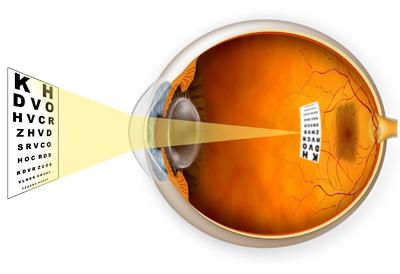
Your eyes aren’t broken. Myopia isn’t a mysterious illness. There is pseudo myopia (a strain symptom), and progressive myopia (a lens-created stimulus). If you take away just one thing from this page, it’s that we look at myopia as a refractive state, and not an “error” or illness. Take a look at this brief video illustration how how your eye’s biology works:
Learn About How Your Eyes Create A Clear Image.
Turning Light Into Image: The Retina.

The retina is in the back of your eyeball. The lens in the front focuses light from far or nearby objects onto the retina. This is where the signal is processed and sent on to the visual cortex in your brain.
Creating Sharp Focus: The Ciliary Body.
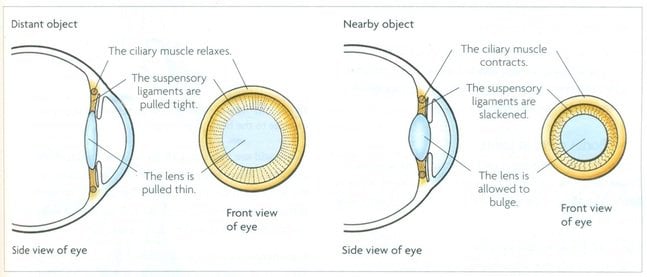
To focus light, your eye uses a flexible lens, and a circular muscle (the ciliary). For distance vision the shape of the lens allows the muscle to be relaxed. When you look up close the ciliary becomes tense to change the lens shape to give you clear close-up vision.
Pseudo Myopia: A Muscle Spasm.
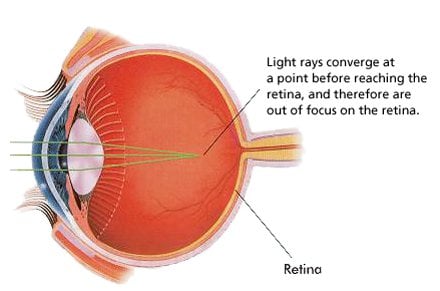
The eye isn’t designed to be in close-up focus primarily. Eventually the ciliary muscle spasms from too much time tensioned. When it fails to fully relax, the lens can not entirely return to distance focus. This is when your distance vision becomes blurred, often referred to as pseudo myopia or NITM (near-induced transient myopia).
Myopia is first pseudo myopia, a focusing muscle spasm, from too much close-up use.
Treating Pseudo Myopia: The Lens Approach.

Pseudo myopia is a focusing muscle spasm. The lens in your eye is still in close-up mode, because the focusing muscle failed to relax. You are looking at a distance, but your lens is still shaped for close-up. As a result, distant images don’t focus correctly on your retina. Result, blurred distance vision. Glasses and contact lenses move the focal plane further back in your eye, giving you back clear distance vision.
Lens Prescriptions Have A Side Effect: Progressive Myopia.
Your Eye Adapts To Stimulus.
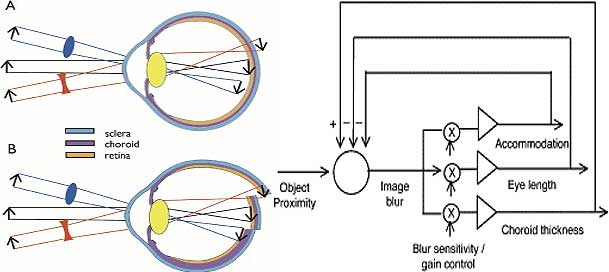
The human eye by design varies the distance from the lens to the retina, by changing in length (commonly referred to as axial change). Most of us are born with eyes “too short”, making us hyperopic as babies (not seeing clearly up-close). Over time the eye adjusts in length, based on environmental stimulus, to give us clear vision at all distances. Note that this is by optical design, the refractive state we mentioned earlier. Our eyes are working as designed, adapting to stimulus.
Glasses Are “Grow Longer” Stimulus.
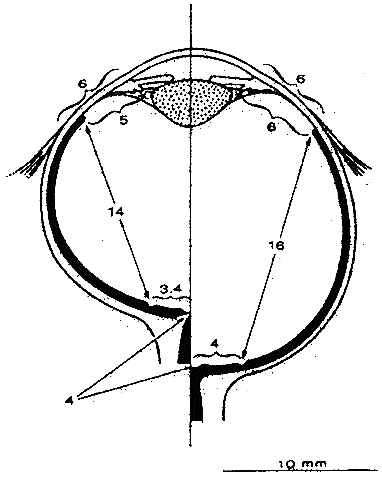
Wearing glasses moves the focal plane back further in your eye. While this works in the short term to suppress the myopia symptom, it also creates a stimulus in your eye. Your eye, as designed, is seeking to correct its length according to the new stimulus.
Result: Your Eyes Grow Longer.
This is what is often referred to as lens-induced or progressive myopia.
The Key To Myopia Reversal: Axial Change Goes Both Ways.
That’s a huge, core, central point to the whole topic of myopia reversal. 1) The eye is a stimulus response machine. Myopia is simply a refractive state, not a defect, illness, or “error”. And 2), axial change goes both ways, ie. refractive state will change based on input. This is why you find hundreds of detailed improvement reports here, and it’s all substantiated by clinical science. In as little as 60 minutes human eye axial change based on lens use / focal plane change is distinctly observable (absolutely click that last link for conclusive clinical evidence that refractive state is a biological reality, and “genetic incurable myopia” simply is false.
Question everything. Especially when those who tell you that you’re somehow a genetic failure and “broken”, also sell you a product to “fix you”. There’s a bit of a conflict of interest there, potentially. Read some of the extensive studies below (as well as lots of other clinical science), mull this all over, come to your own conclusions.
Start Here: 4 Steps To Reduce Diopter Dependence
With all that said, here’s a quick video I put together to help walk you through the basic starting steps for recovering your 20/20 eyesight. It’s actually quite simple in principle, though in reality you do need to learn a few things about your eyesight and lens use.
From here you may want to browse the blog’s how-to guides, diopter discussion, explore improvement reports, and check out our Facebook group and private forum. Time to start getting back to 20/20!
References
1. Mitchell P, Hourihan F, Sandbach J, Wang JJ. The relationship between glaucoma and myopia: the Blue Mountains Eye Study. Ophthalmology 1999;106:2010-5. 2. Lim R, Mitchell P, Cumming RG. Refractive associations with cataract: the Blue Mountains Eye Study. Invest Ophthalmol Vis Sci 1999;40: 3021-6. 3. Tano Y. Pathologic myopia: where are we now? Am J Ophthalmol 2002;134:645-60. 4. Vongphanit J, Mitchell P, Wang JJ. Prevalence and progression of myopic retinopathy in an older population. Ophthalmology 2002;109: 704-11. 5. Saw SM, Chua WH, Wu HM, Yap E, Chia KS, Stone RA. Myopia: gene- environment interaction. Ann Acad Med Singapore 2000;29:290-7. 6. Saw SM, Katz J, Schein OD, Chew SJ, Chan TK. Epidemiology of myopia. Epidemiol Rev 1996;18:175-87. 7. Zadnik K. The Glenn A. Fry Award Lecture 1995. Myopia development in childhood. Optom Vis Sci 1997;74:603-8. 8. Seet B, Wong TY, Tan DT, Saw SM, Balakrishnan V, Lee LK, et al. Myopia in Singapore: taking a public health approach. Br J Ophthalmol 2001;85:521-6. 9. Lin LL, Chen CJ, Hung PT, Ko LS. Nation-wide survey of myopia among schoolchildren in Taiwan, 1986. Acta Ophthalmol Suppl 1988;185: 29-33. 10. LinLL,ShihYF,HsiaoCK,ChenCJ,LeeLA,HungPT.Epidemiologic study of the prevalence and severity of myopia among schoolchildren in Taiwan in 2000. J Formos Med Assoc 2001;100:684-91. 11. LinLL,ShihYF,TsaiCB,ChenCJ,LeeLA,HungPT,etal.Epidemiologic study of ocular refraction among schoolchildren in Taiwan in 1995. Optom Vis Sci 1999;76:275-81. 12. Au Eong KG, Tay TH, Lim MK. Race, culture and myopia in 110,236 young Singaporean males. Singapore Med J 1993;34:29-32. 13. Wu HM, Seet B, Yap EP, Saw SM, Lim TH, Chia KS. Does education explain ethnic differences in myopia prevalence? A population-based study of young adult males in Singapore. Optom Vis Sci 2001;78: 234-9. 14. Dandona R, Dandona L, Naduvilath TJ, Srinivas M, McCarty CA, Rao GN. Refractive errors in an urban population in Southern India: the Andhra Pradesh Eye Disease Study. Invest Ophthalmol Vis Sci 1999;40:2810-8. 15. Dandona R, Dandona L, Srinivas M, Giridhar P, McCarty CA, Rao GN. Population-based assessment of refractive error in India: the Andhra Pradesh eye disease study. Clin Exp Ophthalmol 2002;30:84-93. 16. Dandona R, Dandona L, Srinivas M, Sahare P, Narsaiah S, Munoz ZR, et al. Refractive error in children in a rural population in India. Invest Ophthalmol Vis Sci 2002;43:615-22. 17. Saw SM, Gazzard G, Koh D, Farook M, Widjaja D, Lee J, et al. Prevalence rates of refractive errors in Sumatra, Indonesia. Invest Ophthalmol Vis Sci 2002;43:3174-80. 18. ZhanMZ,SawSM,HongRZ,FuZF,YangH,ShuiYB,etal.Refractive errors in Singapore and Xiamen, China – a comparative study in school children aged 6 to 7 years. Optom Vis Sci 2000;77:302-8. 19. Zhao J, Pan X, Sui R, Munoz SR, Sperduto RD, Ellwein LB. Refractive error study in children: results from Shunyi District, China. Am J Ophthalmol 2000;129:427-35. 20. Zhao J, Mao J, Luo R, Li F, Munoz SR, Ellwein LB. The progression of refractive error in school-age children: Shunyi district, China. Am J Ophthalmol 2002;134:735-43. 21. Saw SM, Hong RZ, Zhang MZ, Fu ZF, Ye M, Tan D, et al. Near-work activity and myopia in rural and urban schoolchildren in China. J Pediatr Ophthalmol Strabismus 2001;38:149-55. 22. Saw SM, Zhang MZ, Hong RZ, Fu ZF, Pang MH, Tan DT. Near-work activity, night-lights, and myopia in the Singapore-China study. Arch Ophthalmol 2002;120:620-7. 23. Garner LF, Owens H, Kinnear RF, Frith MJ. Prevalence of myopia in Sherpa and Tibetan children in Nepal. Optom Vis Sci 1999;76:282-5. 24. Mutti DO, Mitchell GL, Moeschberger ML, Jones LA, Zadnik K. Parental myopia, near work, school achievement, and children’s refractive error. Invest Ophthalmol Vis Sci 2002;43:3633-40. 25. ZadnikK,SatarianoWA,MuttiDO,SholtzRI,AdamsAJ.Theeffectof parental history of myopia on children’s eye size. JAMA 1994;271: 1323-7. 26. Saw SM, Wu HM, Seet B, Wong TY, Yap E, Chia KS, et al. Academic achievement, close-up work parameters, and myopia in Singapore military conscripts. Br J Ophthalmol 2001;85:855-60. 27. Saw SM, Hong CY, Chia KS, Stone RA, Tan D. Nearwork and myopia in young children. Lancet 2001;357:390. 28. Saw SM, Chua WH, Hong CY, Wu HM, Chan WY, Chia KS, et al. Nearwork in early-onset myopia. Invest Ophthalmol Vis Sci 2002;43: 332-9. 29. Hung LF, Crawford ML, Smith EL. Spectacle lenses alter eye growth and the refractive status of young monkeys. Nat Med 1995;1:761-5. 30. Irving EL, Callender MG, Sivak JG. Inducing myopia, hyperopia, and astigmatism in chicks. Optom Vis Sci 1991;68:364-8. 31. IrvingEL,SivakJG,CallenderMG.Refractiveplasticityofthedeveloping chick eye. Ophthalmic Physiol Opt 1992;12:448-56. 32. Irving EL, Callender MG, Sivak JG. Inducing ametropias in hatchling chicks by defocus – aperture effects and cylindrical lenses. Vision Res 1995;35:1165-74. 33. Schaeffel F, Glasser A, Howland HC. Accommodation, refractive error and eye growth in chickens. Vision Res 1988;28:639-57. 34. Schaeffel F, Howland HC. Properties of the feedback loops controlling eye growth and refractive state in the chicken. Vision Res 1991;31:717-34. 35. McBrien NA, Moghaddam HO, Cottriall CL, Leech EM, Cornell LM. The effects of blockade of retinal cell action potentials on ocular growth, emmetropization and form deprivation myopia in young chicks. Vision Res 1995;35:1141-52. 36. Schmid KL, Wildsoet CF. Effects on the compensatory responses to positive and negative lenses of intermittent lens wear and ciliary nerve section in chicks. Vision Res 1996;36:1023-36. January 2004, Vol. 33 No. 1 Preventing Myopia by Natural STOP Growth Signals—I Morgan & P Megaw 19 20 Preventing Myopia by Natural STOP Growth Signals—I Morgan & P Megaw 37. Troilo D, Gottlieb MD, Wallman J. Visual deprivation causes myopia in chicks with optic nerve section. Curr Eye Res 1987;6:993-9. 38. Troilo D, Wallman J. The regulation of eye growth and refractive state: an experimental study of emmetropization. Vision Res 1991;31: 1237-50. 39. WallmanJ,WildsoetC,XuA,GottleibMD,NicklaDL,MarranL,etal. Moving the retina: choroidal modulation of refractive state. Vision Res 1995;35:37-50. 40. Wildsoet C, Wallman J. Choroidal and scleral mechanisms of compensation for spectacle lenses in chicks. Vision Res 1995;35: 1175-94. 41. Bedrossian RH. The treatment of myopia with atropine and bifocals: a long-term prospective study. Ophthalmology 1985;92:716. 42. McBrien NA, Moghaddam HO, Reeder AP. Atropine reduces experimental myopia and eye enlargement via a nonaccommodative mechanism. Invest Ophthalmol Vis Sci 1993;34:205-15. 43. Brown B, Edwards MH, Leung JT. Is esophoria a factor in slowing of myopia by progressive lenses? Optom Vis Sci 2002;79:638-42. 44. Leung JT, Brown B. Progression of myopia in Hong Kong Chinese schoolchildren is slowed by wearing progressive lenses. Optom Vis Sci 1999;76:346-54. 45. Gwiazda J, Hyman L, Hussein M, Everett D, Norton TT, Kurtz D, et al. A randomized clinical trial of progressive addition lenses versus single vision lenses on the progression of myopia in children. Invest Ophthalmol Vis Sci 2003;44:1492-500. 46. Edwards MH, Li RW, Lam CS, Lew JK, Yu BS. The Hong Kong progressive lens myopia control study: study design and main findings. Invest Ophthalmol Vis Sci 2002;43:2852-8. 47. Shih YF, Hsiao CK, Chen CJ, Chang CW, Hung PT, Lin LL. An intervention trial on efficacy of atropine and multi-focal glasses in controlling myopic progression. Acta Ophthalmol Scand 2001;79: 233-6. 48. Saw SM, Gazzard G, Au Eong KG, Tan DT. Myopia: attempts to arrest progression. Br J Ophthalmol 2002;86:1306-11. 49. Kee CS, Marzani D, Wallman J. Differences in time course and visual requirements of ocular responses to lenses and diffusers. Invest Ophthalmol Vis Sci 2001;42:575-83. 50. Miles FA, Wallman J. Local ocular compensation for imposed local refractive error. Vision Res 1990;30:339-49. 51. Winawer J, Wallman J. Temporal constraints on lens compensation in chicks. Vision Res 2002;42:2651-68. 52. GwiazdaJ,ThornF,BauerJ,HeldR.Emmetropizationandtheprogression of manifest refraction in children followed from infancy to puberty. Clin Vis Sci 1993;8:337-4. 53. Morgan IG. The biological basis of myopic refractive error. Clin Exp Optom 2003;86:276-88. 54. Goss DA, Cox VD. Trends in the change of clinical refractive error in myopes. J Am Optom Assoc 1985;56:608-13. 55. Shaikh AW, Siegwart JT Jr, Norton TT. Effect of interrupted lens wear on compensation for a minus lens in tree shrews. Optom Vis Sci 1999;76:308-15. 56. ZhuX,WinawerJA,WallmanJ.Potencyofmyopicdefocusinspectacle lens compensation. Invest Ophthalmol Vis Sci 2003;44:2818-27. 57. NortonTT,SiegwartJTJr.Animalmodelsofemmetropization:matching axial length to the focal plane. J Am Optom Assoc 1995;66:405-14. 58. Kee CS, Hung LF, Qiao Y, Ramamirtham R, Winawer JA, Wallman J, et al. Temporal constraints on experimental emmetropization in infant monkeys. Invest Ophthalmol Vis Sci 2002;43:E-Abstract 2925. 59. SiegwartJT,NortonTT.Whenviewingdistanceiscontrolled,whichlens power competes most effectively to slow myopic compensation to a –5D lens? Invest Ophthalmol Vis Sci 2002;43:E-Abstract 185. Annals Academy of Medicine
